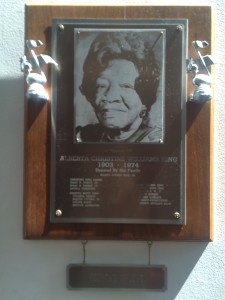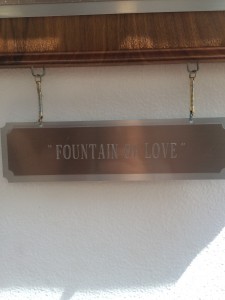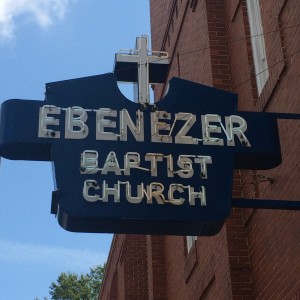For my built environment description, I chose to visit the Historic Ebenezer Baptist Church on the corner of Auburn Avenue and Jackson Street Northeast. I went on a Friday afternoon around 2:00. This was not the original building for the services of the church, but was built in 1914 by the second pastor of the congregation of Ebenezer, Alfred Daniel Williams so that there could be more seating for the congregation that he grew. I went to this site with no true prior knowledge about it other than that it was Martin Luther King Jr.’s home church.
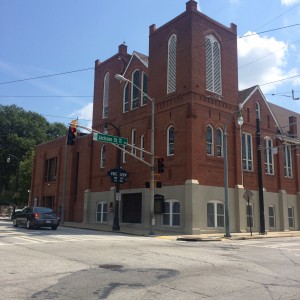 I saw no other people around the building as I walked up and inside the sanctuary at the time of my visit, there were only about ten other visitors. When I arrived, I saw a state park officer standing outside of the building seemingly patrolling the area while also inviting passersby to walk through the church and sit in on a lecture that would be going on downstairs in the next 5 minutes. Talk about good timing! Below are two videos I took during the lecture. It is important to note that the location of the lecture was below the church lobby. NOT THE SANCTUARY.
I saw no other people around the building as I walked up and inside the sanctuary at the time of my visit, there were only about ten other visitors. When I arrived, I saw a state park officer standing outside of the building seemingly patrolling the area while also inviting passersby to walk through the church and sit in on a lecture that would be going on downstairs in the next 5 minutes. Talk about good timing! Below are two videos I took during the lecture. It is important to note that the location of the lecture was below the church lobby. NOT THE SANCTUARY.
As I walked into the lobby area, I was caught off guard. It was unlike any church lobby I had ever stepped foot in. It felt more like a Boy Scouts meeting house due to all the national park signage and the information desk. I suppose this is because it is no longer used as a church, but rather as a historic site to visit to learn and feel its history. 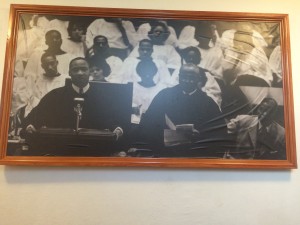
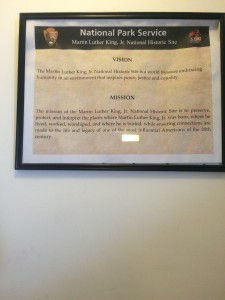
To my right were stairs leading up to Fellowship Hall, where services were once conducted. At each and every turn, on the walls were pictures of Martin Luther King Jr. and/or his family members. There were also multiple postings about the mission and vision of the Nation Park Service. Once I walked up the stairs and into Fellowship Hall, I was immediately taken back to a distant time.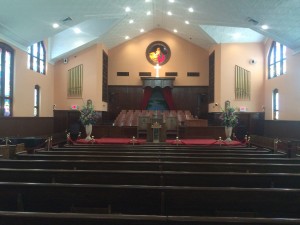 The sanctuary was unlike any that you would see today as it was so symmetrical and minimal. There were only two plants in the front for decoration, and one picture of Jesus situated at the top middle part of the stage area.
The sanctuary was unlike any that you would see today as it was so symmetrical and minimal. There were only two plants in the front for decoration, and one picture of Jesus situated at the top middle part of the stage area. 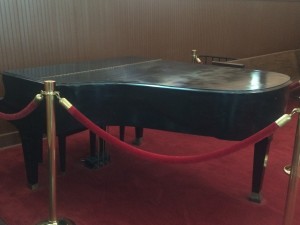 There was also one organ, a replica of the original one where Mrs. King was shot just six years after the death of her son, surrounded by red rope to signify its importance. The pews, arranged in three columns with about twenty rows each, were of cold, hard dark wood. There is one pew that is damaged from a ricochet bullet on the day Mrs. King was killed. The carpet is a bright red. There is also a clock located at the back of the church in the center of balcony that is stopped at 10:30, which is the time at which Martin Luther King’s funeral took place.
There was also one organ, a replica of the original one where Mrs. King was shot just six years after the death of her son, surrounded by red rope to signify its importance. The pews, arranged in three columns with about twenty rows each, were of cold, hard dark wood. There is one pew that is damaged from a ricochet bullet on the day Mrs. King was killed. The carpet is a bright red. There is also a clock located at the back of the church in the center of balcony that is stopped at 10:30, which is the time at which Martin Luther King’s funeral took place.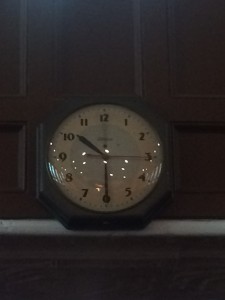 The sanctuary walls were covered with tall, ornate stained glass windows.
The sanctuary walls were covered with tall, ornate stained glass windows. 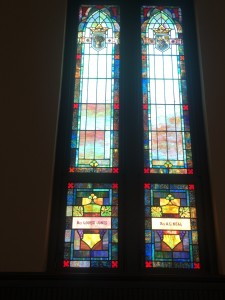 I then descended the stairs that were opposite the stairs I walked up, and the floor separating the sanctuary from the lobby had a small fountain and plaque. The plaque shows that the fountain is the “Fountain of Love” in memory of Mrs. King.
I then descended the stairs that were opposite the stairs I walked up, and the floor separating the sanctuary from the lobby had a small fountain and plaque. The plaque shows that the fountain is the “Fountain of Love” in memory of Mrs. King.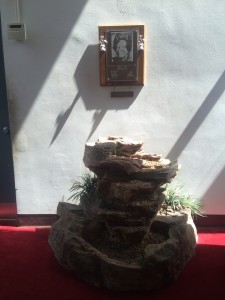 After walking around Fellowship Hall and then back down to the lobby, I went downstairs where a man was giving a lecture about the King family and their involvement in the church. He also did a reenactment of the famous “I Have a Dream” speech by Martin Luther King Jr. He talked about the significance of the artifacts in Fellowship hall, such as the organ and the clock, and he talked about the lasting impact that the King family has had on the church, even though it is no longer active at this site, but rather at another site across the street known as the New Horizon Sanctuary.
After walking around Fellowship Hall and then back down to the lobby, I went downstairs where a man was giving a lecture about the King family and their involvement in the church. He also did a reenactment of the famous “I Have a Dream” speech by Martin Luther King Jr. He talked about the significance of the artifacts in Fellowship hall, such as the organ and the clock, and he talked about the lasting impact that the King family has had on the church, even though it is no longer active at this site, but rather at another site across the street known as the New Horizon Sanctuary.
Overall, I could definitely feel the importance of the site, but I feel that I should also mention that the updates, renovations, and replicas of the artifacts took away from the experience because it detracts from the authenticity of the space. However, the way that the building was transformed from a historical church with great leaders of influence that taught the word of God, to a national historic site solely used to commemorate those leaders is strongly illustrated through the artifacts and wall decoration throughout the interior of the building.
